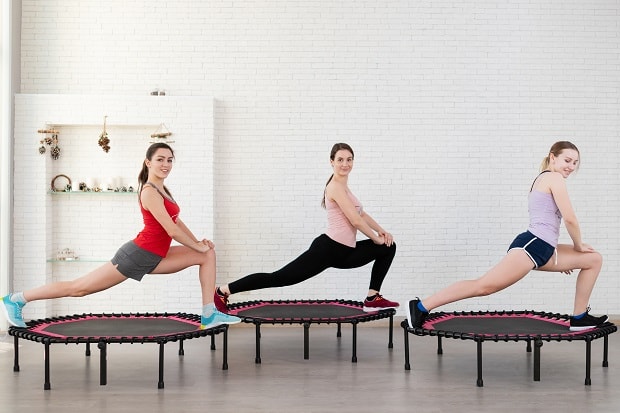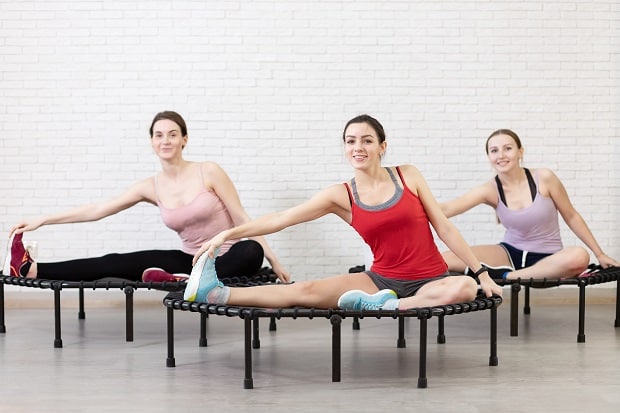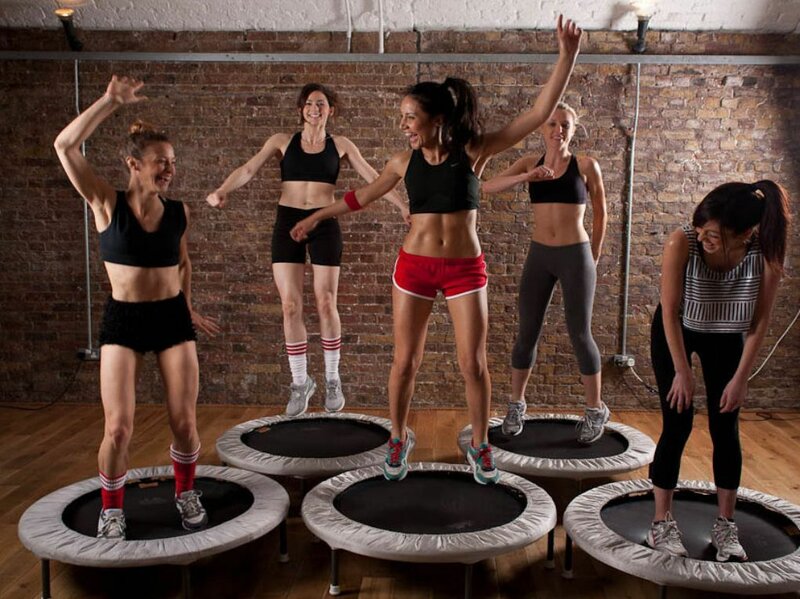
Trampoline Jumping
Simple trampoline exercises burn up to 800 kcal per hour. Workout at home lasts 30 minutes, you can do it 2-4 times a week. This is enough to create a slight energy deficit if you walk for an additional half hour a day and control your diet. The trampoline does not overload the joints and the spine, training on it is not boring. Classes are held in interval mode, which allows you to slightly speed up your metabolism after training.
Is it really possible to lose weight by jumping on a trampoline?
To lose weight, you need to create an energy deficit. The body will gradually burn fat in order to function properly. Fitness training can help increase energy expenditure, speed up metabolism, and strengthen muscles. They are not the only condition for weight loss.
In any case, you must:
- Create a calorie deficit by reducing energy from carbohydrates and keeping protein and fat intake high.
- Do strength training to maintain muscle mass and increase calorie expenditure.
Exercising on a weight loss trampoline is a plyometric exercise. It can be both power and aerobic in nature. It depends on who is jumping and with what intensity. In speed-strength sports, jumps are considered strength work, they are performed at high speed and in large amplitude – for example, a set of jumping out of a squat for 6-10 repetitions. In fitness, these approaches are interspersed with smaller jumps to keep the workout continuous.
Trampoline training is the closest thing to high-intensity interval training according to the exercise protocol. It can boost metabolism, according to research, and is more effective than regular low-intensity aerobic exercise. Also, the jumping activity will save about 40% of the time.
Jumping is good for those who only have 30 minutes to train 2-4 times a week. They can be the only physical activity if you add light weight exercises to them and do everything in an interval style.

Why is jumping fitness useful?
The benefits of jumping fitness:
- availability: inexpensive trampoline, enough for 3-4 years of training;
- the ability to progress at home;
- high calorie consumption per unit of time;
- anti-stress effect;
- working out the muscles of the legs and buttocks in an active mode;
- variability: you can endlessly combine exercises, invent ligaments, experiment with interval modes – this is the motto of a true lover of jumping on a fitness trampoline.
In addition, there are also “club” lessons for those who do not like independent training. There are two directions: mini trampoline and Kangoo Jumps.
- First class includes aerobic warm-up with simple steps, squat to scissor jumps, and soft jumps on two or one legs. All this alternates with strength exercises with microweights on the floor and crunches on the press. The lesson lasts an hour, at the end – stretching. There are no standards for a mini-trampoline, the instructor himself comes up with a program for the group.
- Kangoo Jumps – a group lesson in special boots. Students rent them for an hour from the studio and jump under the guidance of an instructor. This is one of the funniest lessons in the industry, suitable for those who are already fed up with zumba, don’t like fitbox and don’t want to run or walk on a path. The workout is high intensity and allows you to burn up to 900 kcal per hour.
What muscles work when exercising?
Like most high-intensity aerobic lessons, this workout primarily develops the muscles of the lower body.
In dynamics they work:
- whole gluteal group;
- hamstrings and quads;
- calf muscles;
- adductor and abductor muscles of the thighs.
In statics, the abs and back muscles work. The arms and shoulders are also included, especially if balance is required with the arms. During strength exercises, the muscles of the chest, arms and shoulders are modified.
Important: Lessons on a fitness trampoline of any format will not help build muscle. Even if the class is being touted as “glute workout”, it’s more likely to be a simple toning of the muscles. But for increasing calorie consumption, it is very suitable.
Interval trampoline training helps to develop all the muscles in the body evenly. If the goal is to get in good shape in the shortest amount of time, you can work in strength intervals with a progression of weights.
General safety rules for practitioners
A trampoline is not suitable for complete beginners, since their joints and ligaments are not yet ready for such a load. It is better to do strength exercises at home for 2-3 weeks with rubber shock absorbers or without weights at all. Any related YouTube lesson (example below) or a selection of simple exercises like push-ups, squats, lunges, crunches and crunches will do. This will help prepare your muscles and ligaments for exercise.
The heart and blood vessels also need to be strengthened first. For this purpose, half an hour of any continuous aerobic work. Mini stepper, simple walking, exercise bike, bike. After the preliminary stage, you can gradually incorporate jumps into your training schedule. Beginner trampoline exercises can be performed at a slower pace than usual.
In the hall, it is better to do the following:
- Do 2-3 weeks mainly isolating exercises in simulators.
- Optional – any cardio in the simulator for half an hour after the main workout.
- It is worth going to jumping fitness when the pulse, when walking at a speed of 5-6 km / h, stops going beyond 110-120 beats per minute, and on strength exercises will not exceed 140 beats. Yes, the process can be delayed. But otherwise there is a risk of overloading the heart and nervous system.
Home Safety:
- place the trampoline on a non-slip mat;
- learn to jump and jump so that the whole structure does not move back and forth;
- check the height of the ceiling – the highest jump should not be fraught with a headbutt;
- be sure to wear trainers and sportswear, comfortable leggings and a breathable top;
- first learn to jump out of squats, scissors, jump jacks and burpees on the floor, then on a trampoline;
- only then play the video and repeat after the instructor.
Safety in the hall:
- check equipment, fasteners for damage and breaks;
- inform the instructor that there is a beginner in front of him;
- listen to the briefing;
- stand up so that you can see what the instructor is doing;
- don’t try to make high-amplitude movements right away.

